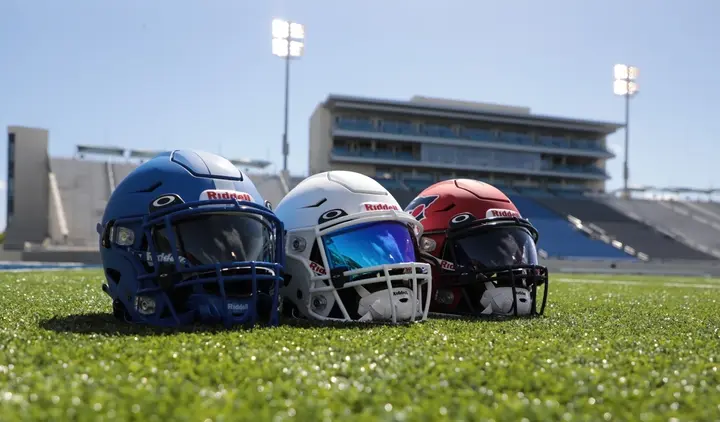In the world of football, player safety is of utmost importance. With the physical nature of the game often leading to intense collisions and potential head injuries, advancements in technology have brought about a new era of football helmets – impact-resistant marvels designed to provide ultimate safety on the field.
These helmets are not just ordinary pieces of protective gear; they are the result of meticulous craftsmanship and engineering excellence. By exploring the cutting-edge materials, innovative design features, and rigorous testing procedures behind these helmets, we will uncover the wonders that lie beneath the surface and understand the significant impact they have had on player safety and the future of the game.
Join us on a journey into the world of impact-resistant football helmets and discover how they are revolutionizing the way we protect athletes on the field.
Key Takeaways
- Impact-resistant helmets are crucial for player safety in football due to the high-impact nature of the sport and frequent collisions.
- High-quality helmets that meet certification standards minimize the risk of head injuries, reduce the likelihood of concussions, and enhance player safety on the field.
- Helmets undergo rigorous testing and certification by organizations like NOCSAE to ensure quality and compliance with safety regulations.
- Technological advancements, such as the use of advanced materials and shock-absorbing technologies, integration of sensors for impact monitoring, and continuous research and development, contribute to improved safety in football helmets.
The Importance of Impact Resistance
Impact resistance is a critical factor to consider when it comes to football helmets, as it plays a crucial role in ensuring the safety and well-being of players on the field. Football is a high-impact sport, with players frequently colliding with each other and the ground. The helmet acts as the first line of defense, absorbing and dispersing the force of these impacts to protect the player’s head and brain.
A high-quality football helmet is designed to minimize the risk of head injuries by incorporating impact-resistant materials and advanced technologies. These helmets are constructed using a combination of hard outer shells, cushioning padding systems, and energy-absorbing liners. The outer shell is typically made of polycarbonate, a strong and durable material that can withstand significant impact forces. The padding systems, such as foam or gel inserts, are strategically placed to provide additional cushioning and enhance the helmet’s impact resistance.
In recent years, advancements in helmet technology have further improved impact resistance. Many helmets now feature innovative designs that incorporate shock-absorbing materials and technologies, such as air-filled chambers or multi-layered construction. These design elements help to distribute the force of impacts more evenly across the helmet, reducing the risk of injury.

Cutting-Edge Materials for Enhanced Safety
Cutting-edge materials are revolutionizing football helmet technology, providing enhanced safety features for players on the field. Manufacturers are constantly exploring new materials and technologies to improve helmet design and better protect players from head injuries.
One such material is thermoplastic polyurethane (TPU), which is known for its excellent impact resistance and flexibility. TPU is used in the construction of helmet shells, providing a strong yet lightweight outer layer that can absorb and disperse impact forces.
Another material gaining popularity is expanded polypropylene (EPP), a foam-like material that is highly energy-absorbent. EPP is often used in the helmet’s interior padding, providing cushioning and reducing the risk of concussions. It is also known for its ability to retain its shape and resilience even after multiple impacts, making it ideal for football helmets.
In addition to TPU and EPP, helmet manufacturers are incorporating advanced technologies such as multi-layered designs and shock-absorbing systems to further enhance player safety. These technologies work together to distribute and dissipate impact forces, reducing the risk of head injuries.
Furthermore, helmet manufacturers are utilizing 3D scanning and printing technologies to create custom-fitted helmets for individual players. This ensures a snug and secure fit, maximizing protection and minimizing the risk of helmet movement during play.
Innovations in Helmet Design and Construction
Continuing the exploration of advancements in football helmet technology, recent innovations have focused on improving the design and construction of helmets to provide even greater protection for players on the field. These innovations aim to address the specific challenges and risks associated with football-related head injuries.
One notable innovation is the use of advanced materials in helmet construction. Manufacturers have started incorporating materials such as carbon fiber, Kevlar, and titanium to increase strength and durability while reducing the overall weight of the helmet. This not only enhances comfort for the players but also improves impact resistance.
Another area of innovation is the helmet’s design. Helmets now feature a more streamlined shape that helps minimize the force of impact and reduce the risk of rotational forces on the brain. The design also includes additional padding and cushioning systems to better absorb and dissipate the energy from a collision.
Furthermore, helmet manufacturers have introduced customization options to ensure a better fit for individual players. This includes adjustable padding, chin straps, and even 3D scanning technology to create helmets tailored to the unique head shape of each player.
The Role of Technology in Impact-Resistant Helmets
The integration of advanced technology has played a crucial role in the development of impact-resistant football helmets. With the aim of enhancing player safety, helmet manufacturers have utilized various technological innovations to create helmets that can better withstand the forces of impact.
One such technology is the use of advanced materials, such as high-strength polymers and carbon fiber composites, which offer superior strength and durability compared to traditional helmet materials. These materials are designed to absorb and disperse the energy from impacts, reducing the risk of head injuries.
Another important technological advancement is the incorporation of impact sensors and data collection systems into helmets. These sensors can detect the magnitude and location of impacts, providing valuable data that can be used to improve helmet design and player safety protocols. This information can help researchers and engineers better understand the forces involved in football-related head injuries and develop more effective helmet designs.
Furthermore, advancements in helmet design have also been enabled by computer-aided design (CAD) and finite element analysis (FEA) software. These tools allow engineers to simulate and analyze the behavior of helmet materials under different loading conditions, helping them optimize the helmet’s structural integrity and impact resistance.
Ensuring Player Safety With Impact Testing and Certification
After the integration of advanced technology in impact-resistant football helmets, the next crucial step in ensuring player safety is through rigorous impact testing and certification. Impact testing is a critical process that evaluates the effectiveness of a helmet in reducing the force of impact on a player’s head during a collision. This testing involves subjecting the helmet to various impact scenarios, simulating real-life game situations, such as linear and rotational impacts.
Certification is another essential aspect of player safety. Helmets that pass the impact testing standards set by organizations like the National Operating Committee on Standards for Athletic Equipment (NOCSAE) receive certification. This certification ensures that the helmets meet the required safety standards and provide adequate protection to players.
Manufacturers must adhere to these testing and certification processes before their helmets can be used in organized football leagues. This ensures that players are using helmets that have undergone rigorous testing and meet the necessary safety requirements.
Additionally, the certification process helps players, coaches, and parents make informed decisions when purchasing helmets, as they can rely on the certification as a mark of quality and safety.
Frequently Asked Questions
How Do Impact-Resistant Football Helmets Help Protect Players From Head Injuries?
Impact-resistant football helmets help protect players from head injuries by absorbing and dissipating the force of impact. They are designed with advanced materials and technology to minimize the risk of concussions, skull fractures, and brain trauma, ensuring the safety of players on the field.
What Are Some of the Advanced Materials Used in the Construction of Impact-Resistant Helmets?
Advanced materials used in the construction of impact-resistant helmets include polycarbonate shells, foam padding, and shock-absorbing systems. These materials work together to provide superior protection by absorbing and dispersing the force of impact, reducing the risk of head injuries in football players.
How Have Recent Innovations in Helmet Design and Construction Improved Player Safety?
Recent innovations in helmet design and construction have greatly improved player safety. Advanced materials such as carbon fiber and impact-absorbing foams are used to enhance helmet strength and reduce the risk of head injuries on the football field.
What Role Does Technology Play in the Development of Impact-Resistant Football Helmets?
Technology plays a crucial role in the development of impact-resistant football helmets. Advanced materials, such as specialized foams and carbon fiber, along with innovative design features, are utilized to enhance helmet safety and protect players from head injuries on the field.
How Are Impact-Resistant Helmets Tested and Certified to Ensure Player Safety?
Impact-resistant helmets are tested and certified to ensure player safety through rigorous testing procedures. These tests include impact simulations, drop tests, and evaluations of helmet materials and design. Certification standards, such as those set by NOCSAE, ensure that helmets meet safety requirements and provide adequate protection.
Conclusion
In conclusion, the advancements in impact-resistant football helmets have greatly contributed to the safety of players on the field. Through the use of cutting-edge materials, innovative design features, and rigorous testing procedures, these helmets provide ultimate protection against head injuries and concussions. As football continues to evolve, the ongoing development of impact-resistant helmets remains essential in ensuring player safety and shaping the future of the game.
You may also like to read:
The Rapid Evolution of Technology: Transforming the World as We Know It





